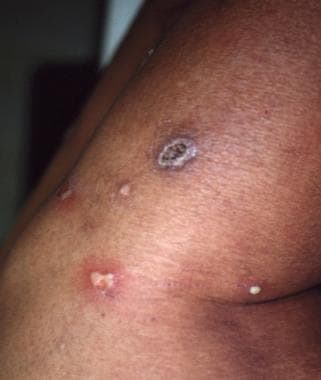Background
Ecthyma is an ulcerative pyoderma of the skin well known to be caused by group A beta-hemolytic streptococci. Concomitant Staphylococcus aureus is often isolated from lesional skin. [1] On occasion, S aureus alone has been isolated. [2] Because ecthyma extends into the dermis, it is often referred to as a deeper form of impetigo.
Pathophysiology
Ecthyma begins similarly to superficial impetigo. Group A beta-hemolytic streptococci may initiate the lesion or may secondarily infect preexisting wounds. Preexisting tissue damage (eg, excoriations, insect bites, dermatitis) and immunocompromised states (eg, diabetes, neutropenia) predispose patients to the development of ecthyma. Spread of skin streptococci is augmented by crowding and poor hygiene.
Etiology
Ecthyma can be seen in areas of previously sustained tissue injury (eg, excoriations, insect bites, dermatitis). Insect bites in the setting of recent travel have been associated with ecthyma. [2]
Ecthyma can be seen in patients who are immunocompromised (eg, diabetes, neutropenia, HIV infection). [3]
Important factors that contribute to the development of streptococcal pyodermas or ecthyma include the following:
-
Crowded living conditions
-
Poor hygiene
Untreated impetigo that progresses to ecthyma most frequently occurs in patients with poor hygiene.
Some strains of Streptococcus pyogenes have a high affinity for both pharyngeal mucosa and skin. Pharyngeal colonization of S pyogenes has been documented in patients with ecthyma. [6] Ecthyma has also been reported in the setting of perianal streptococcal disease. [7]
Epidemiology
Frequency
The exact incidence of ecthyma worldwide remains unknown.
Race
No racial predisposition is recognized for ecthyma.
Sex
No sexual predisposition is recognized for ecthyma.
Age
Ecthyma has a predilection for children and elderly individuals. Outbreaks have also been reported in young military trainees. [6]
Prognosis
Ecthyma lesions are slow to heal but do respond to appropriate antibiotics and local wound care; prognosis is favorable.
Ecthyma rarely leads to systemic symptoms or bacteremia. Lesions are painful and can have associated lymphadenopathy. Secondary lymphangitis and cellulitis, as well as poststreptococcal glomerulonephritis, can occur. Ecthyma does heal with scarring.
Patient Education
For patient education resources, see the Skin Conditions and Beauty Center. Also, see the patient education article Impetigo.
-
Typical ecthyma lesions of the lower extremities.
-
The stages of ecthyma: the lesion begins as a pustule that later erodes and ultimately forms an ulcer with adherent crust.








